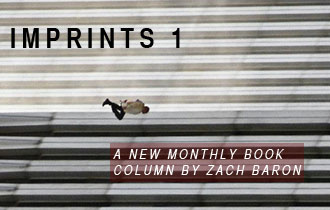IMPRINTS 1: Don Delillo, Simon Rich and Joshua Ferris
19.05.07
 So a friend calls me a few months ago and tells me that he’s going to be fired. Brendan does something ambiguous for a bank, and the bank has been bought. Layoffs are on the way, but not yet: things are moving slowly, and they expect six months before anyone will know their fate. I had just finished Joshua Ferris’s Then We Came To The End, and I mentioned it to Brendan, like maybe he could relate.
So a friend calls me a few months ago and tells me that he’s going to be fired. Brendan does something ambiguous for a bank, and the bank has been bought. Layoffs are on the way, but not yet: things are moving slowly, and they expect six months before anyone will know their fate. I had just finished Joshua Ferris’s Then We Came To The End, and I mentioned it to Brendan, like maybe he could relate.
“I am reading the book you recommended to me,” he wrote a few weeks later. “I am about halfway through, and it is pretty spot on. Everything that is described in there happens here. No work. A lot of gossip. And weird stuff. As far as I know no one steals things or writes on people’s walls, but people are still weird. Also, no one is getting laid off now, so no one is walking spanish, not until July.”
Little bits of plot started showing up at the bottom of his e-mails. “Chris Yop just threw his chair into Lake Michigan.” “Benny sold the totem pole.” Last week, I got a text message that read, People walked spanish today, but not me.
Ferris’s book, about a workplace after the dot-com fall, takes at one point the Tom Waits lyric as slang for getting fired: “At first we called it what you would expect—getting laid off, being let go. Then we got creative. We said he’d gotten the ax, she’d be sacked, they’d all been shitcanned. Lately, a new phrase had appeared and really taken off. ‘Walking Spanish down the hall.’”
Don’t want to flog this idea too hard, but there it is—Ferris walks right out of his novel and into my friend’s office, and here’s the eerie part, when he gets fired, you know he’s carrying his box of personal effects out of there and thinking Tom Waits all the way to the door.
Glimpses of recognition. And why, to throw a rationale out here, we’re bothering to do this in the first place.
 You’ll have already noticed one of the principal quirks of Then We Came To The End: Ferris’s first person plural narrator. Beyond being technically fearsome the voice also provides the mystery that a novel set entirely at work might otherwise lack. Who are we? Why are we here? Immediately, Ferris has the reader collaborating, complicit. But the decision is also an act of mercy: Ferris’s characters are never so alone or so irrational or crazy as to be excluded from the collective voice.
You’ll have already noticed one of the principal quirks of Then We Came To The End: Ferris’s first person plural narrator. Beyond being technically fearsome the voice also provides the mystery that a novel set entirely at work might otherwise lack. Who are we? Why are we here? Immediately, Ferris has the reader collaborating, complicit. But the decision is also an act of mercy: Ferris’s characters are never so alone or so irrational or crazy as to be excluded from the collective voice.
Then We Came To The End is constantly, exceptionally funny, by the way, due mostly to how pitch-perfect Ferris is with his details: “Marcia wanted to eat Jim’s heart because some mornings he shuffled up to the elevators and greeted us by saying, ‘What up, my niggas?’” The second half is obvious, maybe, but it’s the first part, the heart-eating part—that unexpectedly savage turn of phrase—where Ferris makes his living. Ditto for an incredibly long, involved anecdote in which one of the crazier employees, Chris Yop, has fallen into a turf war with an office coordinator over whether or not the things in his office really belong to him, which would be everyday jokes if not for the fact that he can’t stop calling his bookshelves buckshelves, even after the rest of the office corrects him five or six times.
It’s this kind of moment, where the psychology or the personal idiosyncrasy or unvarnished human weirdness just sort of pops out, that also makes Simon Rich’s Ant Farm so blindside touching as well as what it’s supposed to be, which is funny. In one story, “Math Problems,” the second problem of a five-part test is as follows:
2. A math teacher’s new apartment is approximately 12 ft. long and 5 ft. wide, and the bathroom takes up 50% of the apartment. A normal human-size bed is 6 ft. X 3 ft. Does the math teacher have enough room for a standard bed? Or will he have to sleep in some kind of dog bed?
Laughter slamming into the growing recognition of the hidden truth behind the narrative is a technique too, and Rich leans on it hard. “Slumber Party” has the same joke turn up when a bunch of kids on a sleepover decide to track down some parental alcohol, which turns out to be all too easy to track down (“It was in the first place I looked!”). And there’s another one that’s almost too much to take about how this kid’s mom is the proverbial slut who does a whole minor-league hockey team called “My Mom’s All-Time Top Five Greatest Boyfriends.” What they all share is the admission that the thing that makes you laugh the most is the thing that comes out of nowhere to devastate you.
 This idea came to mind again when I was reading Don DeLillo’s new novel, Falling Man. The book tracks an estranged couple as they attempt to reunite in the aftermath of 9/11—the husband, Keith, was in the towers when the planes hit. The book is the subsequent close study of two individuals and of the fissures in their respective facades—fissures perhaps opened by 9/11 but ones that ultimately have deep roots in any number of things that occurred within their relationship before 9/11. These cracks don’t open onto the country or the zeitgeist so much as where you’d expect, which is onto the two people who are unhappily split by them—a la Rich, or Ferris.
This idea came to mind again when I was reading Don DeLillo’s new novel, Falling Man. The book tracks an estranged couple as they attempt to reunite in the aftermath of 9/11—the husband, Keith, was in the towers when the planes hit. The book is the subsequent close study of two individuals and of the fissures in their respective facades—fissures perhaps opened by 9/11 but ones that ultimately have deep roots in any number of things that occurred within their relationship before 9/11. These cracks don’t open onto the country or the zeitgeist so much as where you’d expect, which is onto the two people who are unhappily split by them—a la Rich, or Ferris.
The narrative in Falling Man, such as it is, is drawn out of the tension of which undercurrents in these characters will eventually well up and take over. The couple’s son, Justin, whispers secretively about a man named Bill Lawton and watches the sky to make sure he doesn’t return. Keith’s wife, Lianne, becomes obsessed with a downstairs neighbor who is constantly listening to world-music, which to Lianne sounds “located in the Islamic tradition.” She’s also fascinated with Alzheimer’s patients, taking a job working with them in order to study the process by which their memory declines—a prospect that on one level frightens her and on a deeper level she may find somewhat attractive, allowing as it does a certain kind of retreat. Keith, in one of the more admittedly obviously symbolic turns in the novel, becomes a professional gambler, where the bluffs and turns and chips don’t mean much more than what they’re supposed to: “The value of each chip had only hazy meaning. It was the disk itself that mattered, the color itself.”
DeLillo’s concern in parsing the psychology here seems to have less to do with the events themselves – terrorism, tragedy – than their second- or third-order effects. Benjamin Strong, in a Voice review of Jay McInerney’s The Good Life, wrote that “The Good Life may be the most provocative novel yet about September 11, precisely because it dares to suggest that most of us weren’t changed at all.” People change in Falling Man, but September 11th is mostly the catalyst, and rarely the cause. As Lianne notes, even in the midst of the frantic news cycle in the wake of the tragedy, the newspaper articles and citywide hysteria, “things were ordinary in all the ways they were always ordinary.”
Who knows, I guess, but the process in which DeLillo seems to be interested isn’t coming to terms with the events so much as the ways in which people find to negate them. Towards the end, Lianne finds herself again “ready to be alone, in reliable calm, she and the kid, the way they were before the planes appeared that day, silver crossing blue.” The understated imagery of the colors, the restitution to “the way they were before,” all suggest a process not of elegy but of elision. The cracks are sealed, as are whatever epiphanies they concealed, and things progress.
The point made here seems relevant—at what point do we start needing our novels to be about more than the people who inhabit them? The humor that Ferris and Rich use as a filter—or the tragedy DeLillo uses as his—is the equivalent of critical distance, a way for people to reveal themselves without having to answer why exactly they are the way they are. If we are anything like them then we don’t need an answer either—we already know.
Opening image from The Falling Man, Richard Drew, 2001